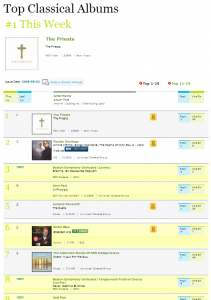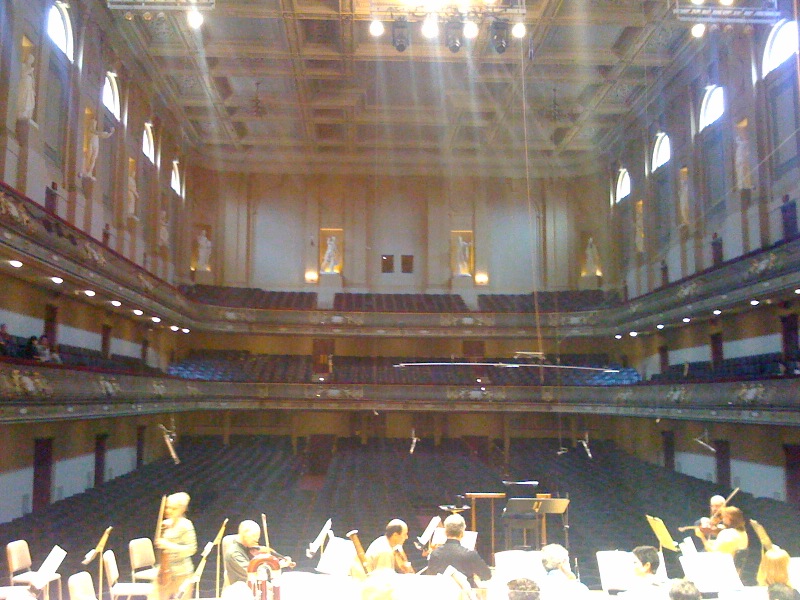 There’s a brief roundup of reviews, among other things, of this weekend’s Beethoven concerts below. The reviews do a good job of pointing out something that we all felt through the residency: this was no quick dash through familiar repertoire. Both conductors brought an insistence on careful preparation and respect for the material, and I think the end product showed it.
There’s a brief roundup of reviews, among other things, of this weekend’s Beethoven concerts below. The reviews do a good job of pointing out something that we all felt through the residency: this was no quick dash through familiar repertoire. Both conductors brought an insistence on careful preparation and respect for the material, and I think the end product showed it.
Some more thoughts on the two pieces. As choral events, they couldn’t be more different. Our conductor likes to point out that many call the Mass in C “Beethoven’s Haydn mass,” and the nature of the commission–for Prince Esterházy on Haydn’s recommendation when the older composer grew unable to write another mass for the Princess’s name day–reinforces that. So does the Mass’s structure: traditionally set, with many quiet moments throughout, it’s no Missa Solemnis. But the uncertainties of the Credo, the leaping harmonic language used to set “God from God, Light from Light,” and a host of other clues show us Beethoven wasn’t phoning this in. It may have been a commission in a traditional manner, but Beethoven’s result was anything but traditional. For me, the work is a window into a search for faith. Rafael Frühbeck de Burgos did it justice by ensuring that the performance exposed the conflicts as well as the clear statements of faith and allowed the searching structure of the piece to be heard.
The Ninth Symphony, written almost twenty years later, continues that search. Twinned as it is with the Missa Solemnis, the work represents the summation of Beethoven’s faith journey. The Missa Solemnis carries the questions raised by the earlier mass to dark places, and ultimately finds, at best, unsettled comfort in traditional religion and religious forms against the drums of war and the awful finality of death. By contrast, Symphony No. 9 confronts war and death head on, tries on chaos, stern struggle and romantic religion, and ultimately finds all of them lacking, choosing instead to take a simple drinking song about the brotherhood of man and rise to the stars with it.
My instinct all weekend was to take the late eighteenth century Enlightenment questions of the role of religion in the fate of man into both the Mass and the 9th Symphony. (It helps that I was finally reading the Jefferson Bible all the way through.) But you don’t have to look very hard to find Beethoven struggling with the same questions that Jefferson seemingly effortlessly addressed through his bold redaction, namely: how much of our received religious tradition is “real” and how much of it has real value? The Ninth’s unity of humanism and religious expression in a divinely inspired joy that enables us to reach to God is of a piece with Jefferson’s insistence on the greatness of Christ’s teachings quite apart from the question of his godhead.
…And so, somewhat to my surprise, we’re at the end of another Tanglewood season, the end of another summer. I have no idea how that happened so quickly. It seems just yesterday that we were setting our clocks ahead, and now the days are getting shorter and the kids are getting ready to go back to school.
And we’ll be returning to the basement chorus room at Symphony Hall. I don’t know yet whether I’ll be in the first performance of the season, the Brahms Deutsches Requiem with James Levine back at the podium, but I sure hope so.
I collected all my photos from Tanglewood this summer, including the ones I took last weekend, into a Flickr set for posterity (also linked from the photo above). The big difference this year is that all the photos were taken with my iPhone, because my good camera has been missing somewhere since the middle of the summer (alas). I like the iPhone better as a camera than my two previous camera phones–the image quality seems better and less smeary–but it suffers the same issues as they do, namely uncertain color balance when shooting in bright light.







